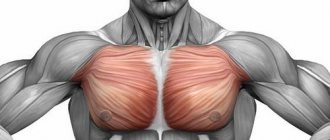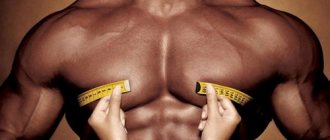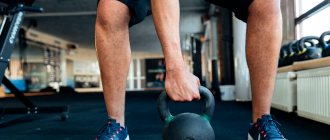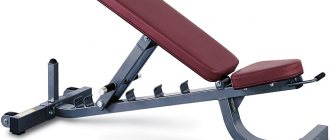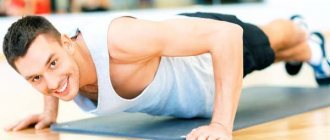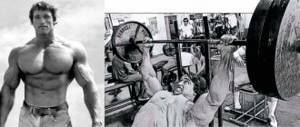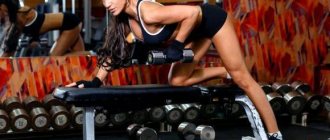Perhaps the most powerful exercise with kettlebells is the overhead throw and press. The element creates a complex load on large muscles and allows you to develop endurance and strength. The “casting” technique consists of two movements: lifting the projectile to the shoulder and pushing it over the head. We offer a detailed analysis of both parts of the exercise and the advantages of combining them in one.
Which is better: kettlebells or dumbbells?
It is not for nothing that the kettlebell is considered a very specific and highly sought-after equipment.
Dumbbells are much easier to hold in the palm of your hand, which ensures that all the small muscles are pumped, but mainly only the arms are used. When lifting a weight, the load is distributed throughout the body, which ensures better performance of entire muscle groups. During such movements, the muscles of the arms, back, abs, legs and even buttocks work intensely, and it is very difficult to concentrate on any particular muscle. Another advantage of dumbbells is the easily adjustable weight. Kettlebells in this regard are significantly inferior in convenience. There are only four common weights: 8, 16, 24 and 32 kilograms.
At the same time, the weights are very easy to use. One exercise is enough to effectively train the muscles of the whole body. Thus, just one weight can replace the gym, which is especially important if training can only be done at home.
Exercises with a kettlebell greatly accelerate blood circulation throughout the body, which not only has a beneficial effect on metabolism, but also increases the chances of quickly building muscle mass if a person is genetically predisposed to rapid pumping.
The main advantage of kettlebells is the ability to pump a whole range of muscles at once.
The volume will increase very quickly:
- biceps;
- triceps;
- pectoralis major muscle;
- deltoid muscles of the chest;
- latissimus dorsi muscles.
For beginners, it is better not to take very heavy shells. The optimal weight for beginners is 16 or 24 kilograms.
What muscles work?
The movement can be roughly divided into two phases: the sumo-style deadlift and the close-grip chin row.
When deadlifting, the main work falls on:
- adductor muscles of the thigh;
- gluteal muscles;
- quadriceps
The hamstrings and spinal extensors work a little less.
When the knees are fully straightened, we begin to pull the weight towards the chin. The main muscle groups working in this case are the deltoid muscles (especially the anterior bundle) and trapezius. A small portion of the load also falls on the biceps and forearms.
During the entire movement, the abdominal muscles act as stabilizers; thanks to them, we maintain balance and prevent the weight from falling down too sharply.
Triceps training program
In one day you can simultaneously train, for example, leg muscles and triceps.
Set of exercises
This complex is suitable for both beginners and pros, but if this training regimen is too difficult for you, remove one of the first two exercises.
- Close grip bench press: 3 sets of 8 reps. Rest 3 minutes.
- French press: 3 sets of 8 reps. Rest 3 minutes.
- Dumbbell overhead press: 3 sets of 12-15 reps. Rest 2 minutes.
- Close-grip push-ups: 3 sets of 12-15 reps. Rest.
There are several options for how to pump up your triceps with dumbbells. You can even create your own complex, you just need to consider the type of exercise: isolated or basic. The program should contain two isolated and two basic exercises.
Everything in training is the same as in life. Set goals for yourself, dream and bring your plans to life. The poorest person is not the one who has no money, home and family, but the one who does not have happiness and dreams.
Article sponsor -
Updated: 12/23/2019 03:32
General recommendations
The most important thing to always remember is compliance with safety precautions. You can use magnesia powder in case of increased sweating of the palms, so as not to accidentally drop the projectile
An equally important aspect is proper nutrition. Athletes should consume large amounts of protein to quickly increase muscle mass. No less important in the diet are complex carbohydrates (porridge) and natural vitamins contained in vegetables and fruits. If you exercise, you should drink more water than a sedentary person. The norm for you is 2.5-3 liters per day.
A number of recommendations relate directly to the training:
- At the very beginning, it is better to choose a kettlebell weighing 8 kilograms.
- When training with this apparatus, the most important thing is the correct technique, not the number of repetitions.
- The load must be increased slowly so as not to injure the joints and spine.
- Muscles must have time to rest and recover from previous exercises, so the optimal frequency of training is 2-3 times a week.
If you follow these simple rules, you can train with kettlebells both in the gym and at home without fear for your health and well-being.
What to do if your arm muscles are weak?
If you cannot hold a load in your hands for a long time, you need to pay more attention to training your arms and increasing the strength of your hands and forearms. The latter are used when bending/extending the arms when exercising with dumbbells/kettlebells on the shoulder muscles, biceps and triceps. If they are weak, resort to static loads. The simplest thing is to hold the load in your hand for some time. When you can hold it for 20 seconds or more, increase the weight by 5 kg.
Grip strength also needs to be trained. Use wrist expanders for this. Squeeze and unclench it for 10 seconds. This is 1 repetition, in a workout there should be 10 of them in each of 6 approaches.
Types of kettlebell exercises
The kettlebell can be used as the main equipment for exercises, i.e., build the entire workout based on exercises with kettlebells. At the same time, each exercise is suitable for a separate, additional training for muscle development. This is due to the significant overall load when working with weights. In addition, approaches using one hand or both are distinguished. Naturally, you need to switch from exercises with two hands to exercises with one. When should you make the transition? At the moment when it turns out to be technically correct and easy to perform the same exercise with both hands.
Specific exercises include:
- Power swings of kettlebells.
- Raising a weight to the chest.
- Kettlebell snatches and jerks.
- Kettlebell presses.
- Squats and walking with weights.
Standing one-arm kettlebell lift
Performed in a standing position.
The kettlebell must be grabbed by the handle with one hand, with an underhand grip. For precise and fixed movements, it is recommended to start by placing your elbow on the side of your body. In this position, the body is shifted slightly forward. Bending should be done slowly, counting once or twice. The kettlebell is raised to a level as close as possible to the shoulder, but not brought to the end. The brush must remain in the down position. All this is done while exhaling.
The inhalation is accompanied by lowering the hand to the count of one-two-three. Each bending is accompanied by a change of hand. The optimal number of repetitions is 8-12 times for each hand. The number of approaches is developed individually, but you should aim for 3-4 approaches.
A more complicated version of this exercise involves using two identical weights and alternating flexion and extension of the arms.
Seated biceps curl
The exercise technique is similar to the standing one-arm kettlebell lift, but significantly increases the effective load on the shoulder muscles.
To perform this, you need to sit down with your feet shoulder-width apart and your feet wide apart, with an underhand grip. In this version of the exercise, it is already necessary to rest the elbow on the inner surface of the thigh. This time the exhalation is accompanied by bending the arm as close to the shoulder as possible. An indicator of the correct result is tension in the biceps at the peak of flexion.
It is worth paying attention that as you exhale, you cannot fully extend your elbow, because
this leads to involuntary and unnatural flexion of the elbow joint. Extension should occur smoothly. You should do 6-8 repetitions on each hand. The number of approaches remains the same.
Power Chest Raise
Taking a weight to the chest is accompanied by lifting the projectile from the ground to the shoulder. This happens in one smooth movement. Despite its apparent simplicity, you need to be very careful when performing it, since it does not involve standard muscle contractions and causes certain inconvenience.
The chest raises themselves are not performed. They are done in conjunction with the presses described above.
To perform the exercise, stand with your feet shoulder-width apart. Bend your knees slightly. The weight should be in a longitudinal position in relation to the performer. Underhand grip.
As you exhale, the weight rises with acceleration to shoulder level.
Returning to the exercise of lifting a kettlebell with one hand while standing, it is important to note that you should not bring your hand point-blank to your shoulder. The legs should straighten smoothly during the process.
As you exhale, the hand smoothly lowers to the starting position, but the weight is not placed on the floor until the end of the approach.
Bend the torso to the sides
The initial position is feet shoulder-width apart, one weight in hand. The arm is straight and pressed to the thigh. Top grip.
Particular attention should be paid to the back in this exercise. The tilt must be accompanied by a mandatory return to the starting position, which assumes a straight back
It is recommended to stand against a wall at first to ensure proper technique.
Exhalation is accompanied by tilting towards the weight. When performing a tilt, you need to stay at the maximum point for 1 second.
As you inhale, we return to the starting position. Then the hand with the kettlebell changes and the repetition begins. You cannot force only one side of the torso with this exercise. Alternately changing the load on each part of the body is much more effective and will protect against overextension of the ligaments.
The optimal repetitions tend to be 10-12 in 3-4 sets for each hand.
By performing these simple kettlebell exercises as recommended, you can build your strength and endurance in a balanced and safe manner. A high level of control over movements and precision in their execution create a clear and understandable image of your body, which cannot be achieved using other equipment.
The best exercises with a kettlebell:
Classic kettlebell exercises
Classic complexes with kettlebells include the following exercises that involve the muscles of the upper body:
Jerk . In a standing position, place your feet slightly wider than your shoulders, toes turned to the sides. This is the basic stance in kettlebell lifting. We take the weight with one hand, then lean forward a little and bend our knees slightly. We move our free hand behind our back, and with the other, swinging the weight back between our legs, we push it up. The projectile moves by inertia and is fixed in a position where the arm and body form one straight line. He lingers in this position for 1 second, after which he lowers down on a straight arm. When moving down, the body moves forward slightly again. Breathing – inhale when swinging, exhale when fixing.
Push . We take a basic stance. Squatting down a little, lift the weight with a straight grip and throw it over your chest. We tilt the body slightly back. Then, standing on your toes, we begin to push the weight up. During the push, we lower ourselves back onto our heels and do a small squat. Only when the arm with the projectile is completely straight, do we straighten our legs. The final point of the exercise is to lower the weight back onto your chest. Breathing - inhale before pushing, exhale when fixing.
These exercises with kettlebells involve not only the chest, shoulders and arms, but also the muscles of the back and legs. The movements are complex, so you need to start performing them with minimal weights until the technique is perfected. Ideally, classes should be supervised by a qualified trainer. If he is absent, ask at least one of your friends to monitor your movements from the side. As for the number of repetitions, the more the better. Professionals perform over 100 similar movements in 10 minutes.
Pros and cons of kettlebell lifting
- Versatility. With kettlebells you can do exercises on your shoulders, arms, chest, back and any other muscle groups.
- Minimum inventory. This is a definite plus for home workouts. For a beginner to get a full workout, 1 piece of equipment will be enough to start with. This saves not only the budget, but also space in the apartment, since unlike barbells and exercise machines, weights do not require much space for storage.
- Simultaneous development of strength and endurance. When training in the gym, we increase either one or the other, varying the weights and the number of repetitions. Kettlebell lifting involves long-term exercise with fairly heavy equipment weight, which has a positive effect on both strength and endurance.
- Cardiovascular health. This benefit is also explained by the duration of strength training, during which the heart is subjected to positive stress.
- Development of coordination.
- Integration with other sports. To improve their skills, representatives of various martial arts, track and field athletes and other athletes turn to kettlebells.
With all the advantages, kettlebell lifting also has its disadvantages:
- Inability to gain impressive muscle mass. A champion weightlifter in terms of volume will lose to an ordinary amateur athlete from the gym. This sport is for those who are interested in the functionality of the body, and not just appearance.
- Injury hazard. Incorrect technique when exercising with a kettlebell can very easily lead to injury. However, the risk is not much higher than using free weights at the gym.
Thus, the advantages of kettlebell lifting significantly outweigh its disadvantages. Classes with kettlebells are ideal for those who do not strive for huge muscles, but want to become strong and resilient. However, you will still look more athletic than the average untrained person. And the intensity of the exercises will help you get rid of excess weight in a short time, which makes kettlebell lifting attractive for women. In addition, here ladies definitely should not be afraid to “swing”, since the possibility of gaining muscle mass is limited.
What is a kettlebell used for and what is its effectiveness for the body?
There is a difference between this discipline and bodybuilding. Kettlebell fitness is used to work the body completely. It can be compared to weightlifting, where the potential of muscle groups helps lift the weight. Bodybuilding, in turn, works differently: the focus is on a separate muscle group.
Kettlebell exercises can develop strength, and it, as athletes know, is determined not by muscle mass, but by the strength of the ligaments. That is why kettlebell lifting is practiced in military structures.
Training with kettlebells for beginners is a difficult process, because characteristics such as coordination, strength and perception of amplitude are not developed. Because of this, beginners abandon this sport without getting the desired result.
It should be immediately noted that the potential of this discipline is great, including the growth of strength indicators, muscle mass and improvement of one’s own body.
What muscles work during training?
First, you need to highlight the areas of work with this inventory:
- classic exercises for kettlebell lifting;
- adaptation of equipment for bodybuilding;
- fitness with weights.
Kettlebell fitness is practiced by both girls and men for cardio and body work. In this case, all muscle groups and ligaments are involved in the exercises.
Often inexperienced athletes try to pump up their muscles with kettlebells, adapting this equipment for bodybuilding. This method, according to experts, is considered incorrect. It looks like this: a person takes bodybuilding exercises and performs them with a weight
It is important to understand that the amplitude of this instrument is completely different, so concentration on a separate muscle group during the exercise is difficult to achieve
Classic kettlebell lifting is the work of the whole body and each muscle group. The exercises work the back, gluteal muscles, leg muscles, shoulder girdle and other small muscle groups. During kettlebell training, you should not concentrate only on the muscles, because joints and ligaments also play a role in every movement, which must be approached with no less responsibility.
Are kettlebells effective for weight loss and muscle growth?
A set of exercises with a kettlebell can both rid the body of excess weight and increase it additional kilograms of muscle mass. All that is needed for this is to correctly manage the exercises and the weight of the equipment.
Muscle mass grows after serious stress to the body that occurs during heavy training
It is important to distinguish between working on strength and working on mass, because these are two different directions. In our case, we use exercises with kettlebells that maximize the potential of each part of the body.
In this case, the working weight is 60% of the maximum performance of a particular person. You should not forget about proper nutrition to increase muscle mass.
Kettlebell fitness as a means of losing weight is very common in gyms. Every movement contributes to cardiac pacing. The more energy expended on a kettlebell exercise, the more energy is required for recovery. It follows that if you eat right, energy will be drawn not from food, but from stored fat layers. Exercises with a 16 kg kettlebell are better suited; this weight will allow you to do more repetitions.
Kettlebell Training Tips
A kettlebell training program should be designed by a professional, taking into account the athlete’s capabilities. With this you can achieve maximum effect. Also, the trainer can lift the weight correctly so as not to injure the spine and joints.
When training in the gym, always start the exercise by warming up your body, which will protect your body from injury and discomfort during exercises with a kettlebell. It is also recommended to keep your body warm, because warmed muscles and joints are less susceptible to injury.
How to choose a quality kettlebell
For real weightlifters, the quality and shape of the selected kettlebell is important, which will allow you to perform exercises without feeling discomfort.
The first thing you need to pay attention to is the length of the handle. The longer it is, the less the joint will turn out during movement.
This kettlebell is especially good when performing one-arm presses.
A 16 kg weight should be different in shape from heavier equipment so that the athlete can quickly navigate.
Lunges
Kettlebells can also be used instead of dumbbells. If their weight is between 8-12 kg, they are good for working on lunges. In themselves, they are an incredibly effective aid in working on the formation of rounded and toned buttocks. It is through this exercise that women can model for themselves that very attractive lordosis curve that so attractively draws a female silhouette. Therefore, the use of the described sports equipment will come in handy, especially in home training conditions, where there are no exercise equipment.
What is the technique for doing lunges with kettlebells? There are two alternative options, each of which is good in its own way.
The first option is step-by-step. The technique for doing it is quite simple:
- Starting position: feet shoulder-width apart, back straight, arms down along the body and holding the weights with a grip.
- On the count of “one”, the right leg performs a step forward movement, the knee bends at a right angle, without protruding beyond the toe. At the same time, the body remains straight, the back is straight, the emphasis is on the heel, and the left leg is laid back and the knee almost touches the floor.
- On the count of “two,” the body rises, the back (left) leg is placed against the front (right), the weights are smoothly transferred along with the body in a forward movement one step.
- On the count of “three,” the left leg makes a step forward movement, and now the load is transferred to the left heel, and the muscles of the left gluteal muscle are brought into tension.
- On the count of four, the body rises again and returns to its starting position, preparing for the next step with the weights in the lunge.
The second option is to work out the exercise on the spot. Lunges with a transverse interception of the weight from one hand to the other allow you to burn the gluteal muscles and the back of the thigh no less effectively. The technique for performing them is no less simple than the technique for working out the step-by-step method:
- Starting position: legs at a distance of a foot from each other, back straight, body straight, weight in the right hand.
- On the count of “one,” the right leg is pulled back, the left leg is bent at the knee at a right angle, the knee does not protrude beyond the toe. Meanwhile, the right hand is moved to the area between the legs and throws the weight into the left hand in a cross motion relative to the left leg. In this case, there is a clear load on the buttock and the posterior femoral surface of the left leg.
- On the count of “two,” the left hand picks up the weight, the right leg returns to the left leg, the body unbends and straightens to its original position.
- On the count of “three,” the left leg is pulled back, the right leg is bent at the knee at a right angle, and the left hand throws the weight over to the right. The tension, meanwhile, is coordinated on the buttock and the back of the thigh of the left leg.
The kettlebell here plays the role of an unconditional weighting agent, which contributes to a greater load on the buttocks area and an increase in muscle mass in this part.
Kettlebell Snatch
One-arm kettlebell snatches help develop chest muscle strength and provide a good cardio workout. During class, follow this technique. Place your feet slightly wider than shoulder level. Place the sports equipment between your legs. Bend over to the kettlebell, trying to maintain a straight back. Grab the handle with one palm and move your pelvic area back slightly. Swing the kettlebell lightly back between your lower limbs. Next, pull the projectile using the force of the upper part of the body in the opposite direction. Create momentum and move the kettlebell in a wide arc in front of you. Bring the weight at arm's length above your head. Describing the same wide semicircle with the projectile in space, return to the starting position.
Exercises for the pectoral muscles with a barbell in the gym
Basic exercises for working the chest muscles include various types of techniques, the most popular of which remains exercises using a barbell.
Bench press in a lying position on a bench without tilting. Performing this exercise uses the pectoralis major muscle. Helps girls strengthen their breasts.
Correct technique:
- In the initial position, you need to lie on a bench, tightly fixing your lower back, arms with the apparatus spread out to the sides at right angles, elbows directed towards the floor.
- As you inhale, a pushing movement is made, the bar is brought up, the forearm looks at the floor.
- When exhaling, you must return to the original position.
Approaches are performed - 3, 15 repetitions with optimal weight.
Bench press while lying on an incline bench. The involvement of the pectoral muscles complements the involvement of the triceps and deltoids.
How to do it:
- In the initial position, you should lie on a bench with an incline, your feet are pressed to the floor, your hands on the apparatus are shoulder-width apart.
- The bar must be lowered below the chest line when inhaling, and the elbows should not be moved far from the body.
- As you exhale, your arms return to their original width.
Approaches – 3, repetitions with working weight are 15.
Smith's head-down barbell press. This type of exercise allows you to work the muscles of the lower chest. For girls, this will help tighten their breasts.
How to do the exercise:
- Place a negative incline bench under the machine so that the bar is parallel to your chest line.
- Lie on a bench, pressing your lower back and buttocks tightly, with your legs behind the bolsters.
- As you inhale, remove the barbell and lower it to your chest, elbows pointing to the floor.
- As you exhale, take the starting position.
The number of repetitions can be increased to 20, since this technique eliminates free weight and is easier to perform.
Features of training with kettlebells
Training with kettlebells has its own characteristics and nuances, which we will talk about now.
- Multiplicity
The weight of any weight is a multiple of four, that is, it is divided by this number. There are weights - 4, 8, 12, 16, 20, 24, 28, 32 kilograms, etc. It is worth taking this into account and understanding. But if we are realistic, we need to understand that most gyms have weights of 16, 32 and sometimes 24 kilograms. We are not talking about any 12 or 20 kilograms.
- Center of gravity
The kettlebell is one of the implements that constantly changes its center of gravity throughout the movement. This unique property is both a plus and a minus. Constantly changing the center of gravity of the projectile develops stabilizer muscles, but increases the risk of injury, especially for beginners. It is worth taking this feature into account.
- Bruises and pain on the forearms
Due to its design, the kettlebell puts a lot of pressure on the athlete’s forearm. Lifting weights on a regular basis will leave bruises on your forearms. Bruises will cause unpleasant pain.
- Magnesium and grip strength
Kettlebell training requires a strong grip, especially in some exercises. Using straps when training with kettlebells is stupid because your grip will remain weak. Magnesia will help solve this problem. Usually the kettlebell slips out of your hands not because of a weak grip, but also because of sweaty palms.
- Load on the spine
Almost all kettlebell exercises place significant stress on the spine. Athletes with a healthy spine need to engage in prevention to maintain athletic longevity and health.
- Technique
If you disdain the correct technique, you risk getting injured and forgetting about your favorite equipment and the sport in general for a long time. Improve your technique constantly, even if you achieve good results.
- Mode
Training with weights is the same as training in the gym. No one has canceled the observance of sleep and nutrition.
Which is better, kettlebells or dumbbells?
Kettlebells are a very specific exercise machine. Let's look at their main differences from the more familiar dumbbells. Dumbbells are much easier to use, and thanks to them, all the smallest and narrowly specialized muscles are worked out
When using a kettlebell, almost the entire body is involved, covering both the arms and back, and even the muscles of the abs, legs and buttocks; it is much more difficult to pay attention to a particular muscle
In addition, dumbbells are much easier to change weights, the weight range is quite wide, while kettlebells use 4 main weights: 8 kg, 16 kg, 24 kg and 32 kg.
One of the main advantages is that it is easy to use. You can have just one piece of equipment, but using various exercises you can easily replace going to the gym. This type of training is excellent at accelerating your metabolism, just like other strength training. In previous articles you can learn more about the complex with weights at home.
It is impossible to talk about which weighting agent is better, because they work completely differently.
It’s no secret that weights only in the form of kettlebells will not help you become a professional bodybuilder, but they can easily help you qualitatively improve your physical fitness. This equipment is especially suitable for people prone to athleticism. Strengthening all muscle groups and improving endurance will be greatly facilitated by training with kettlebells.
If you have not yet acquired the necessary sports equipment in the form of weights, dumbbells, barbells or exercise machines, hurry to the online store, where you will be presented with the widest range of goods for sports, health and an active lifestyle.
I have already said that with kettlebells you cannot work only one muscle, which means that several groups will be involved, namely, in addition to the biceps, they will work:
- triceps;
- shoulder;
- pectoralis major muscle;
- deltoid muscles of the shoulders;
- latissimus dorsi muscles.
What kettlebell weight should I choose to start with?
In kettlebell lifting, 3 types of equipment are used:
- 16 kg;
- 24 kg;
- 32 kg.
But for fitness training, more varied equipment is produced in increments of 1-2 kg, so a suitable weight can be selected for any initial physical data.
For exercises on the arms and shoulders, you can get by with a 16 kg kettlebell. For stronger pectoral muscles, you will need a heavier apparatus, especially if you are not a beginner and are simultaneously working out in the gym. Such people can be guided by the working weight in the bench press. If it is less than 100 kg, take a 16 kg weight. If you bench press more than a hundred, you will need a projectile of 24 kg, and possibly 32 kg. For women's training, 8 kg weights are suitable, but if you are in very poor physical shape, you can start with 4 kg.
A set of exercises for the pectoral muscles for girls at home
If you don’t have time to go to the gym, but want to have sculpted and toned breasts, you can use a system of exercises for the chest muscles at home.
- Push ups. At home, you can perform the classic version or push-ups on stools. To do this, the emphasis with your hands must be placed on some hill: chairs, a stack of books. The wider your arms are, the better the pectoral muscles work.
- Loading your chest strength with your palms. This exercise is familiar to many. To perform this, you need to fold your hands in front of you and press your palms against each other as hard as possible for 15 seconds. Then relax and do at least five approaches.
- Bench press at home. The bench press is the main load for the chest muscles; you can do it at home using improvised equipment - identical bottles of water, bags of sugar. It is necessary to lie down on a flat surface, press firmly on your lower back and feet, bend your arms at the elbows, and press the projectile to your shoulders. As you inhale, you need to stretch your arms up, and as you exhale, return to the starting position.
Features of biceps training with kettlebells
All the features of training with a kettlebell are related to its unique shape. The wide handle on the barrel-shaped core allows for different gripping options. Thus, the same exercise, performed with a different grip, will work different parts of the same muscle.
To develop the short head of the biceps muscle, you need to grab the kettlebell by the core with your palms. Placing your hands on the sides of the round part, they bend in such a way that the inner side of the biceps is worked, where the short head is located.
If you take the weight by the handle and turn it upside down, the shoulder muscle begins to work. It is located directly under the biceps. The increase in strength is accompanied by growth of both muscles. In addition, lifting the kettlebell in this position also engages the upper pectoral muscles.
The barbell, in turn, does not provide the opportunity to separately develop or refine the desired part of the biceps muscle.
Unlike dumbbells, kettlebells have a very unusual grip for developing biceps, but this is normal. In this position, a larger number of muscle fibers develop, and the growth and development of new parts of the body is always an inconvenience.
It is important to remember that exercises with a kettlebell are, at their core, power jerks. Therefore, you need to take care of your joints and ligaments
To do this, just like with leg exercises, you need to place your hands at the same level as your forearm. This makes it harder to perform the exercises, and the overall load may even decrease, but this way the health of the joints is guaranteed.
Pump up spectacular pectoral muscles with weights
Men who have no contraindications for health reasons, aged 16 to 45 years, who previously regularly engaged in dumbbell gymnastics and brought their weight to 10-12 kg can exercise with weights.
For various exercises, depending on strength, weights of different weights are used, a set of different types of weights from 16 to 32 kg (16, 20, 25, 32 kg). It is recommended to start training with 16 kg, after 3-4 months of regular training you can move on to sports weights weighing 20-25 kg, and after a year - to heavy weights weighing 32 kg.
There is no need to rush to increase the load. You should move to higher weights according to the following rule: if you can perform the exercise without breaking the technique 15 times, then you can increase the weight so that the exercise can be done 5-6 times.
You can exercise with weights daily or at least 2-3 times a week. It is advisable to include exercises with weights in a dumbbell gymnastics complex. It is extremely important to exercise at the same time: during the day, if possible (1.5-2 hours before lunch), but better in the late afternoon (2-3 hours after lunch).
Advice!
Before you start exercises with weights, you need to do 6-8 exercises with dumbbells to warm up. If classes are held outdoors, then it is good to jog for 1-2 minutes followed by a slow walk.
On the subject: How to properly build muscles in the gym
How to lift a kettlebell?
So, here are two effective exercises that will help build impressive pectoral muscles:
Two kettlebell bench press
You need to place the weights on the floor slightly wider than your shoulders. Lie on your back, weights are in line with your head. Grasp the handles of the weights with your hands deeper with an underhand grip and place them on your chest.
For one: forcefully squeeze the weights up onto straight arms;
by two: smoothly lower to the starting position.
Repeat 4-10 times.
Clue:
For greater and better impact on the pectoral muscles, it is better to squeeze weights while lying on a bench.
Lifting weights while lying overhead
You should lie on your back, place the weight behind your head, and grab the handle of the weight with both hands with an underhand grip.
For one: lift the weight up in front of you with straight arms;
by two: lower to the stomach;
on three: move your straight arms with the weight back, behind your head to the starting position.
Repeat lifting and releasing 6-10 times.
After completing the exercises, you need to pause for rest for 60-80 seconds. While resting, breathe deeply.
Source: https://www.prostomen.com.ua/telo/stati/kachaem_effektnye_grudnye_myshtsy_s_pomoschyu_gir
How to pump up muscles with kettlebells and gain mass
1. Lifting kettlebells for biceps.
A small weight kettlebell is used and is performed separately and alternately on each arm.
Starting position: sitting, the elbow of the trained arm rests on the thigh, we flex and extend the arm, straining the biceps.
If the weight is too heavy for you, then cheating is possible.
2. Alternating lifting of weights for biceps while standing.
We try to perform the exercise as cleanly as possible. We use cheating only if the weights are large.
3. How to pump up muscles with kettlebells: standing kettlebell press.
This exercise engages the triceps and deltoid muscles. It can be done with either one or two weights. We avoid the pushing technique and use only the bench press.
It is easier to perform the exercise with one kettlebell.
To increase the load, you need to perform the bench press from a sitting position.
4. Lifting the weights from behind the head.
This exercise works the triceps. Available only to experienced athletes, since the weight of the kettlebell is rarely less than 16 kg.
We lift from behind the head with one hand, the other hand is on the triceps and fixes the position of the working hand.
Warm-up before exercise is required: push-ups, light massage.
5. Bent-over kettlebell row.
The latissimus dorsi muscles are trained.
One hand rests on the stool, the back is arched, we pull the weight to the belt, we try to perform deadlifts only due to the work of the back muscles.
6. How to pump up muscles with kettlebells: bent over row of 2 kettlebells.
Starting position: the body is tilted forward, the back is bent, we perform a row of 2 weights to the belt. We make sure that the back does not round and that the arms work synchronously.
7. Kettlebell chest press on a horizontal bench while lying down.
Exercise to work the pectoral muscles. When performing the exercise, the weights should move in parallel. If you want to work the upper chest, then do the exercise on an incline bench, the optimal inclination angle is 45 degrees.
8. Lifting weights while lying down.
In this exercise you need to control your hands, as the likelihood of injury is very high.
9. Squats with kettlebells.
Hardly suitable for gaining weight in the legs, but ideal for good muscle tone.
Now you know how to build muscle with kettlebells!
In addition to the listed exercises, there are many others through which it is possible to pump up muscles with kettlebells.
When performing exercises with weights, you need to pay special attention to controlling the fixation of your hands. If you cannot do this, you can secure your hands with an elastic bandage
I hope I answered your question on how to build muscle with kettlebells.
Have you decided to send your child to a children's tennis school? The MEGASPORT-TENNIS school, presented on the website https://www.mstennis.ru/school.aspx, is best suited for this.
Is it possible to pump up with weights without using exercise machines and other equipment in the gym? – beginner athletes often ask. Indeed, in the 21st century, there is often not enough time to visit the gym, but you can take a weight with you everywhere, even in the car, and use it in a traffic jam on the highway, in the office, and at home. It’s absolutely possible to pump up with kettlebells, trainers say. The main thing is not to be lazy and train constantly.
Why haven't you read this yet? Well, this is in vain...
How to choose the right kettlebell?
The range on the market is represented by classic rounded options for professionals, prefabricated and bulk types. Prefabricated shells are individual plates that are connected together to obtain the desired weight. The main advantage is cost-effectiveness. When choosing, pay special attention to quality, because... the projectile may disintegrate overhead.
The bulkheads are empty inside. Adjust the weight by pouring sand into them. The disadvantage is that you need to constantly weigh and pour the filler.
They are classified by shape into square, disc-shaped, skull-shaped, and with 2 handles. For exercises for all muscle groups, choose the classic version.
Made from metal and plastic. The latter are not the best choice because their center of gravity shifts.
The comfort of the temple is an important parameter. Therefore, before purchasing a projectile, lift it up. If the kettlebell doesn't rest on your forearm when hanging down, but instead rests on your wrist, pick up another kettlebell. You will need a larger temple size. Its thickness also plays a role. If it is very thick, the risk of injury increases.
Technique for lifting kettlebells onto biceps with two hands
Option #1.
- Performed standing, knees slightly bent, palms on the sides of the kettlebell handle.
- Hands begin moving from below the hips. You can also turn the kettlebell over from top to bottom, holding the handles on the sides from below, this technique will turn on the brachialis.
- Exhale: without leaning back, keeping your elbows motionless, we bend your arms, bringing the weight to your chest. In addition to the biceps, feel the work of the upper chest.
- Inhale: Without throwing, gently lower the kettlebell
, keeping your elbows bent to prevent ligament injuries.
Do not swing or throw weight. In this case, the throwing technique, like that of weightlifters, is prohibited. Concentrated work is important, lifting should be done only with the biceps
.
To keep the technique clean, you can rest your back against the wall
.
Any option is performed 8–12 times, 3–4 approaches
.
Option No. 2.
In this version, hold the weight not by the handle, but by the sides of the widest part. The grip should be strong, so don’t use too much weight.
, the main thing is not to miss the weight.
- In a standing position, hold a kettlebell with both palms.
- Exhale: Fully bend your elbows toward your chest without rocking your torso.
- Inhale: Gently straighten your arms, keeping your elbows slightly bent.
If both options with a weight of 16 kg are light, perform a superset - first lift the weight 12 times
grab the handle, then immediately perform option No. 2, also
12 times
.
Rest
1-2 minutes between sets.
Kettlebell swings + squats
The two-hand kettlebell squat is a combination exercise that combines a kettlebell swing with a squat. The goal is a smooth transition between the two parts of the movement, thus engaging the entire body at once.
Performance:
1) take the weight with both hands; feet stand slightly more than shoulder-width apart; lower your arms straight down in front of you so that the weight is between your legs; 2) with a swinging motion, lightly throw the weight in front of you, while straightening your back; 3) while throwing the kettlebell, lower yourself into a squat (you should catch it with your palms by the core already in a sitting position); 4) as soon as you catch the kettlebell at the bottom of the exercise, stand up and then lower it down (you need to catch the kettlebell with both hands by the handle); when the kettlebell is again in a hanging position at hip level, proceed to the next repetition.
Advice. Before you begin squatting kettlebell swings, do a few reps of two-arm kettlebell swings.

